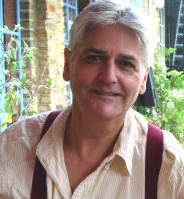Cognitive Mapping and Radio Drama by Alan Beck - Consciousness, Literature and the Arts, Volume 1 Number 2, July 2000
also at http://blackboard.lincoln.ac.uk/bbcswebdav/users/dmeyerdinkgrafe/archive/cog.html
SECTION 10
10.1 Objects in outline Gestalts
But what do I 'see' here? Shapes, outlines or objects in all their detailed 'presence'? Let me analyse more generally at this point. Radio drama's filtering out means that the objects represented in so many plays - doors opening and closing, steps, the acoustic allowing me to hear voices within the dimensions of a domestic room, a cave or a cathedral, Spot effects of cups and glasses, FXs of car doors and engines - are to be grasped in their relatively simple, emblematic, perhaps at times almost abstract properties or outline Gestalts. Gestalt is defined here as a psychic whole formed by the structuring of the perceptual field, and especially so in the limited perceptual field of radio. In my cognitive-perceptual tracking, I 'see' outlines: a three-dimensionality of edges and lines, patches of 'colour', tones, the volumes resulting from sound events in space, etc. At their most basic, and stripped of their narrative context, these are relatively simple stimuli. Of course, and this is back to referentiality in radio, other listeners may 'concretize' the fictional events more fully and colourfully than I have.
However, there are links across my whole perceptual array (sight, smell, touch, hearing, taste). On what is termed the internalist model of the human sensorium - and so back to phenomenologist Merleau-Ponty - aural perception is in some way penetrated by the other modes. The listener 'sees', 'tastes', 'smells', etc., or at least many anecdotally so report, as I said above. The various modalities are always present or potentially so. In real-life interaction for example, even tactility, the physical sensation of touch, is linked to mental information of the texture of spaces, and complex socio-cultural references (personal and universal, intimate and distant, literal and figurative). So 'tangible' / 'intangible,' 'material' / 'immaterial,' 'visible' / 'invisible' exist in parallel to each other. I could sum up this phenomenological approach by saying that radio both is, and is not, 'invisible'.
10.2
I recognise the radio equivalent of invariants - elements perceptually invariant even under transformation. These crucially affect radio drama's limited vocabulary in the non-verbal domains and they are the means for generating expectations and my filling-in of missing information. Of course, when used creatively, invariants (in the play excerpt, the STORM SOUNDS and TOM-TOMS) offer the radio director many opportunities. This is just one particular approach to the relatively limited stock of radio drama's FXs (sound effects). Filling-in is the compensation that the listener makes for what radio has filtered out in its representation of the extra-radio world.
So as I orienteer through the play, I transfer over, in my meaning-making, some attributes of my own Lifespace: shape, size, relative distance and directions. This is the validating process or concretizing I mentioned above (Ingarden 1973), when I introduced the topic of referentiality - the listener's task of conjuring up in the mind and imagination. I have to rely on my own memory storage and personal experiences (Branigan's schemata and Forrester, 2000, 1.4 on our 'cultural repertoire'), for as the philosopher Nelson Goodman says, worlds are always made from other pre-existing worlds (Goodman, 1978, 48).
10.3
Radio of course, filters out and excludes incoming 'information' from the extra-radio world, like a character's facial appearance, colours and smell. (See also Crisell, 1994, 10). But I can recognise all of the cues en route. They are most often dialogue in the foreground balanced against an atmos background (often traffic or rain and in 'Ingredient X', the STORM SOUNDS and TOM-TOMS), or some FX sound effects (boiling the kettle, opening the door, footsteps going 'off' up the stairs), or dialogue in a neutral acoustic.
To SECTION 11 - Cognitive mapping in the radio studio

Academic material on this site is  Alan Beck
is licensed under a Creative Commons Attribution-Non-Commercial-Share
Alike 2.0 UK: England & Wales License.
Alan Beck
is licensed under a Creative Commons Attribution-Non-Commercial-Share
Alike 2.0 UK: England & Wales License.
See more of Alan Beck's work.
To the WELCOME PAGE for Alan Beck's site.
Learn about radio drama on this site along with my book - Beck, Alan, Radio Acting, London: A & C Black ISBN 0-7136-4631-4
Available on Amazon. CLICK HERE.
